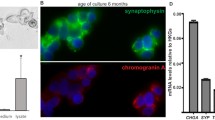Summary
Administration of Compound 48/80 to rats for 5 days resulted in an increase of the specific type of mucosal mast cell, while connective tissue mast cells elsewhere were almost completely degranulated. The number of mucosal mast cells increased slowly for another 5 days and then returned to the control level, in an exponential manner. The half life of the newly formed mast cells was calculated to be about 40 days. This value may be taken as an estimate of the half life of mucosal mast cells. These cells, therefore, constitute a fraction of mast cells with rapid turnover. Available evidence indicates that the classical connective tissue mast cell has a very long life span, without significant turnover in terms of cell death and cell renewal. We suggest that the increase of mucosal mast cells is an indirect effect of Compound 48/80, related to its effect on other mast cells and mediated by material(s) released from these cells during the secretory process.
Similar content being viewed by others
References
Baltzly, R., Buck, J.S., De Beer, E.J., Webb, F.J.: A family of long-acting depressors. J. Am. Chem. Soc. 71, 1301–1305 (1949)
Blenkinsopp, W.K.: Mast cell proliferation in adult rats. J. Cell Sci. 2, 33–37 (1967)
Bloom, G.D., Haegermark, Ö.: A study on morphological changes and histamine release induced by Compound 48/80 in rat peritoneal mast cells. Exp. Cell Res. 40, 637–654 (1965)
Enerbäck, L.: Mast cells in rat gastrointestinal mucosa. 1. Effects of fixation. Acta Pathol. Microbiol. Scand. 66, 289–302 (1966a)
Enerbäck, L.: Mast cells in rat gastrointestinal mucosa. 2. Dye-binding and metachromatic properties. Acta Pathol. Microbiol. Scand. 66, 303–312 (1966b)
Enerbäck, L.: Mast cells in rat gastrointestinal mucosa. 3. Reactivity towards Compound 48/80. Acta Pathol. Microbiol. Scand. 66, 313–322 (1966c)
Enerbäck, L.: Mast cells in rat gastrointestinal mucosa. 4. Monoamine storing capacity. Acta Pathol. Microbiol. Scand. 67, 365–369 (1966d)
Enerbäck, L., Lundin, P.M.: Ultrastructure of mucosal mast cells in normal and Compound 48/80 treated rats. Cell Tissue Res. 150, 95–105 (1974)
Fawcett, D.W.: Cytological and pharmacological observations on the release of histamine by mast cells. J. Exp. Med. 100, 217–224 (1954)
Miller, H.R.P.: Immune reactions in mucous membranes. II. The differentiation of intestinal mast cells during helminth expulsion in the rat. Lab. Invest. 24, 339–347 (1971a)
Miller, H.R.P.: Immune reactions in mucous membranes. III. The discharge of intestinal mast cells during helminth expulsion in the rat. Lab. Invest. 24, 348–354 (1971b)
Miller, H.R.P., Jarret, W.F.H.: Immune reactions in mucous membranes. I. Intestinal mast cell response during helminth expulsion in the rat. Immunology 20, 277–288 (1971)
Miller, H.R.P., Walshaw, R.: Immune reactions in mucous membranes. IV. Histochemistry of intestinal mast cells during helminth expulsion in the rat. Am. J. Pathol. 69, 195–206 (1972)
Mota, I., Beraldo, W.T., Junqueira, L.C.U.: Protamine-like property of Compound 48/80 and Stilbamidine and their action on mast cells, Proc. Soc. Exp. Biol. (N.Y.) 83, 455–457 (1953)
Mota, I., Beraldo, W., Ferri, A.G., Junqueira, L.C.U.: Action of 48/80 on the mast cell population and histamine content of the wall of the gastrointestinal tract of the rat. Ciba Foundation Symposium on Histamine, pp. 47–50. London: J. & A. Churchill, Ltd. (1956)
Murray, M., Miller, H.R.P., Jarret, F.H.: The globule leucocyte and its derivation from the subepithelial mast cell. Lab. Invest. 19, 222–234 (1968)
Padawer, J.: Quantitative studies with mast cells. Ann. N.Y. Acad. Sci. 103, 87–138 (1963)
Padawer, J.: The reaction of mast cells to Polylysine. J. Cell Biol. 47, 352–372 (1970)
Padawer, J.: Mast cells: extended lifespan and lack of granule turnover under normal in vivo conditions. Exp. Mol. Pathol. 20, 269–280 (1974)
Riley, J.F., West, G.B.: Tissue mast cells. Studies with a histamine-liberator of low toxicity (Compound 48/80). J. Path. Bact. 69, 269–282 (1955)
Röhlich, P., Andersson, P., Uvnäs, B.: Electron microscopic observations on Compound 48/80-induced degranulation in rat mast cells. J. Cell Biol. 51, 465–483 (1971)
Veilleux, R.: Acridine orange fluorescence of mast cells as influenced by fixation. Histochemie 23, 319–327 (1970)
Veilleux, R.: Staining properties of duodenal mast cells in 48/80-treated rats. Histochemie 34, 157–161 (1973)
Author information
Authors and Affiliations
Additional information
Supported by grants from the Swedish Medical Research Council, Project no 2235
Rights and permissions
About this article
Cite this article
Enerbäck, L., Löwhagen, GB. Long term increase of mucosal mast cells in the rat induced by administration of Compound 48/80. Cell Tissue Res. 198, 209–215 (1979). https://doi.org/10.1007/BF00232005
Accepted:
Issue Date:
DOI: https://doi.org/10.1007/BF00232005




